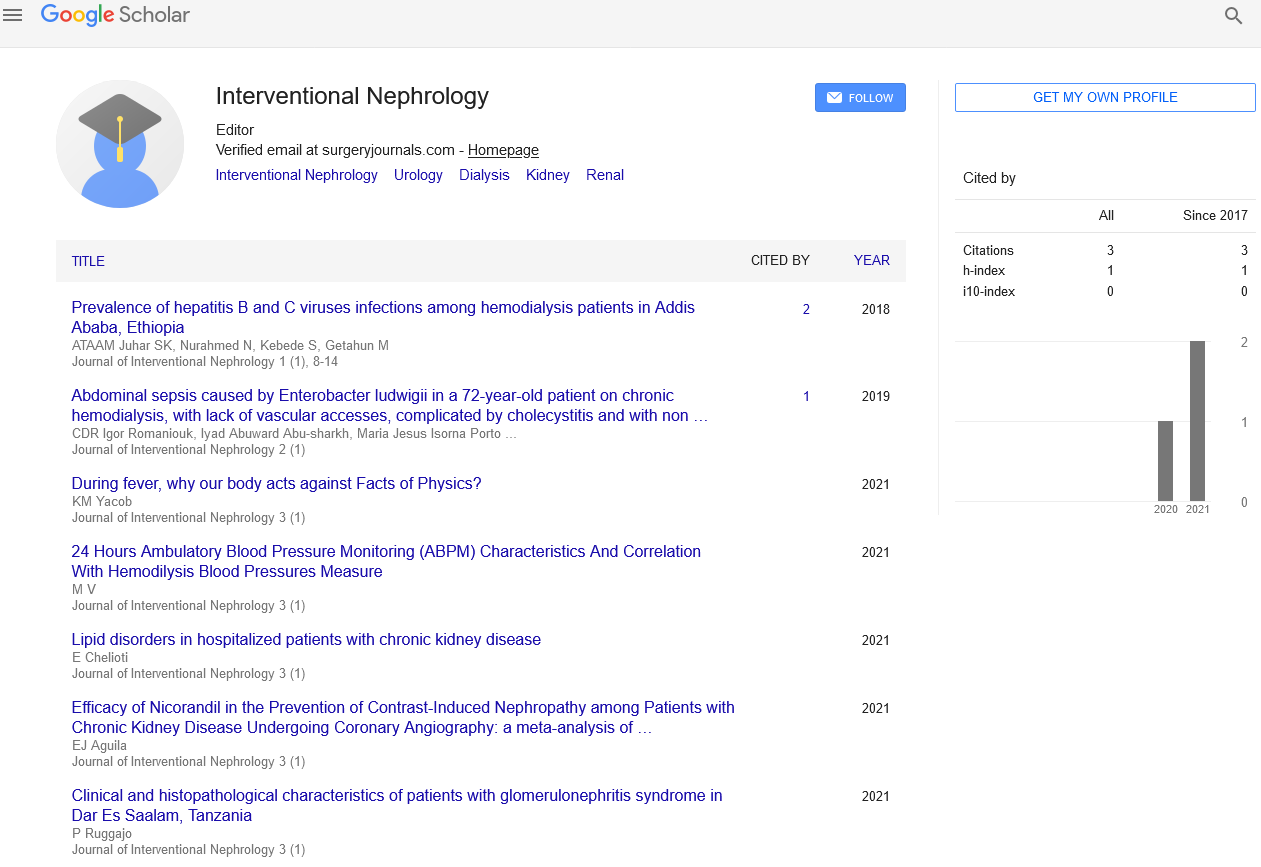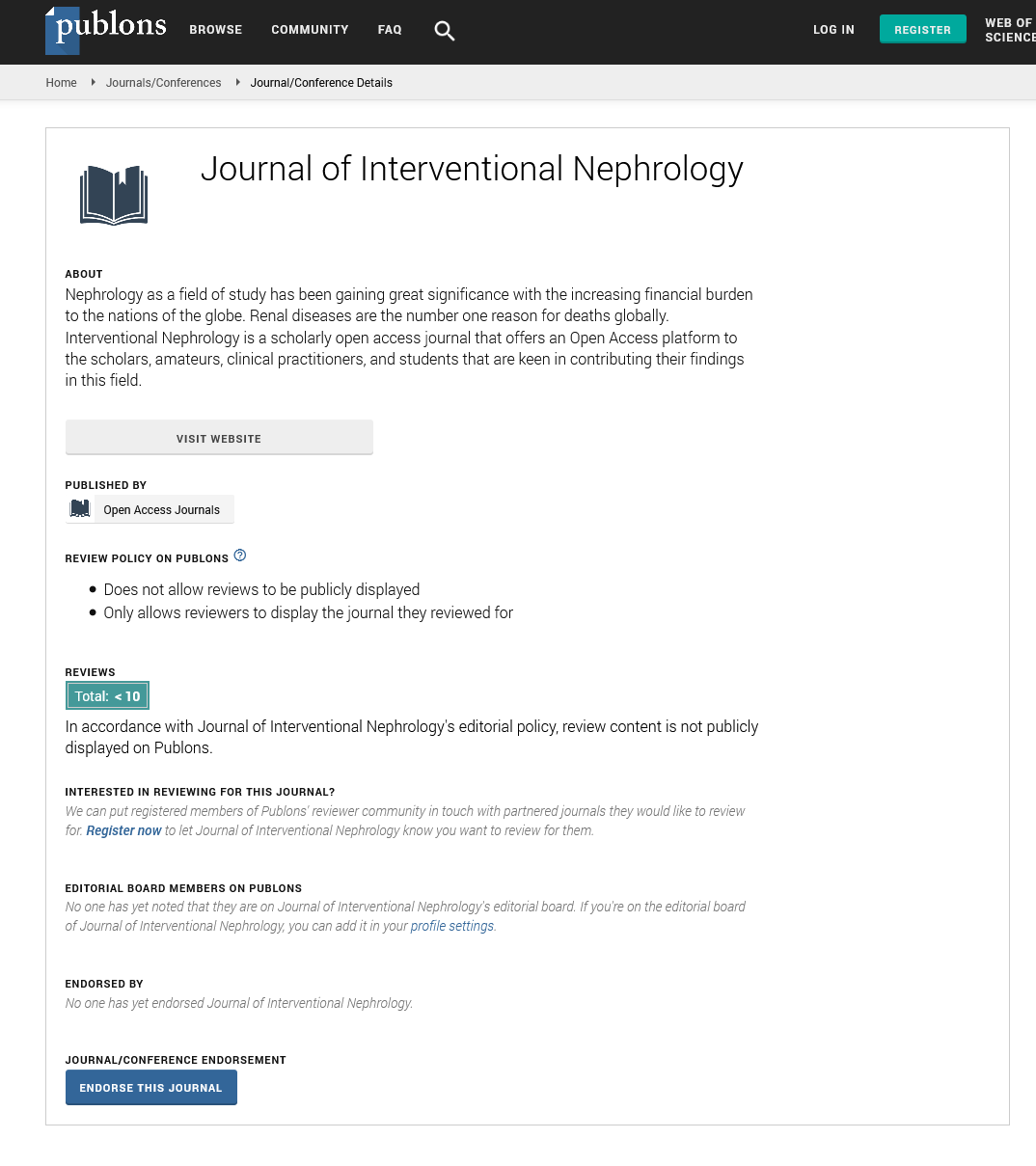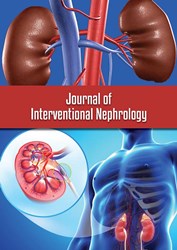Mini Review - Journal of Interventional Nephrology (2023) Volume 6, Issue 1
Effects of Chronic Kidney Disease on Oxidative Stress, Immune Deregulation, and Mitochondrial Dysfunction
Mouin Seikaly*
Louisiana State University Health Sciences Center, Pediatric Nephrology, Shreveport, LA, USA
Louisiana State University Health Sciences Center, Pediatric Nephrology, Shreveport, LA, USA
E-mail: mouinseikaly@hdz-nrw.edu
Received: 01-Feb-2023, Manuscript No. oain-23-88899; Editor assigned: 04-Feb-2023, PreQC No. oain-23- 88899(PQ); Reviewed: 18-Feb- 2023, QC No. oain-23-88899; Revised: 25-Feb-2023, Manuscript No. oain-23-88899(R); Published: 28-Feb-2023; DOI: 10.47532/ oain.2023.6(1).16-19
Abstract
Airflow restriction and significant lung tissue loss are hallmarks of the progressive and incapacitating illness known as chronic obstructive pulmonary disease (COPD). Cigarette smoke has been linked to an increased oxidative burden on a variety of lung cell types, making it a major risk factor for the development of COPD. Increased reactive oxygen species (ROS) levels may have a major impact on the expression of biological molecules, the function of signalling pathways, and antioxidant defence. Large amounts of ROS are released by inflammatory cells including neutrophils and macrophages, although mitochondrial dysfunction is a key factor in ROS production because of oxidative phosphorylation. Although mitochondria are dynamic organelles, excessive oxidative stress has the ability to change their morphology, RNA content, and function. Indeed, fusion and fission, which are necessary activities to maintain a sound and functional mitochondrial network, can cause mitochondria to change their shape. These processes are regulated by the proteins mitofusin 1, mitofusin 2, and ocular atrophy 1. Smoking cigarettes can lead to mitochondrial hyperfusion, which lowers the ability of the cells to withstand stress and maintain mitochondrial quality. Additionally, decreased levels of mitophagy-related enzymes like Parkin (an ubiquitin ligase E3) and the PTEN-induced putative kinase 1 (PINK1) are frequently seen in COPD and are directly related to the disorder’s improper clearance of damaged mitochondria and subsequent cell senescence. In this review, we focus on the key mechanisms for mitochondrial quality maintenance and how oxidative stress affects them throughout the onset and progression of COPD.
Keywords
chronic kidney disease • oxidative stress • pulmonary disease • microglia • neuroinflammation • fibrosis
Introduction
Over 300 million people worldwide suffer from chronic obstructive pulmonary disease (COPD), a lung illness that slowly worsens over time. According to the Global Initiative for Chronic Obstructive Lung Disease, 3 million people die each year from COPD, a number that is predicted to increase over the next 40 years as populations in high-income countries age and smoking rates rise in poorer nations. A preventable and treatable illness called COPD is characterised by a gradual airflow restriction that may or may not become wholly or partially permanent. With the potential to prevent the decrease of lung function, corticosteroids are regarded as the gold-standard treatment for COPD since they reduce patients’ symptoms and lengthen the time between exacerbations.
However, corticosteroids do not stop the progression of the disease, and some individuals do not benefit from these treatments because of steroid resistance brought on by smoking [1].
Due to exposure to harmful particles or gases, airflow limitation typically results in an increased, chronic inflammatory response as well as tissue remodelling in the airways and lung parenchyma. Furthermore, the severity of COPD is directly correlated with concomitant illnesses and exacerbations. Because of the numerous chemicals that trigger the generation of reactive oxygen species (ROS), which causes an oxidant burden, cigarette smoke is the main risk factor for COPD. The development of COPD in nonsmokers is the consequence of a complicated interaction between a person’s genetic predisposition (such as a deficiency in -1 antitrypsin) and prolonged exposure to noxious particles and gases (such as occupational exposures to vapours, gases, dusts, or fumes) [2].
An imbalance between the generation of endogenous antioxidants and oxidants derived from ROS leads to oxidative stress. Exogenous and endogenous oxidants are linked to the development of COPD. Electrons are removed from molecules during the chemical process of oxidation; afterwards, leaky electrons result in the production of reactive free radicals. Major external sources of ROS generation include industrial pollution, car exhaust fumes, occupational dust exposure, and cigarette smoking. Environmental contaminants and inhaled hazardous gases also contribute to the creation of ROS [3].
The generation of oxidants occurs mostly in mitochondria, one of the main endogenous sources of ROS. Up to 12 potential sites connected to nutrient oxidation and the electron transport chain (ETC) can produce mitochondrial ROS. These sites are further broken down into two subgroups: the reduced nicotinamide adenine dinucleotide/ nicotinamide adenine dinucleotide (NADH/ NAD+) isopotential group and the ubiquinol/ reduced ubiquinone (UQH2/UQ) iso Depending on the kind of cell and the tissue, these various locations contribute differently to the overall release of O2 and H2O2, which appears to be linked to the availability of substrate and mitochondrial bioenergetics. In the ETC, electrons move through four respiratory chain complexes before reacting with molecular oxygen to produce superoxide (O2) [4]. These complexes are complex I (NADH-coenzyme Q reductase), complex II (succinate dehydrogenase), complex III (coenzyme Q-cytochrome c reductase), and complex IV (cytochrome c oxidase). In order to create an electrochemical proton gradient () that ATP synthase uses to synthesise ATP, energy generated when electrons are transported through the ETC is used to pump protons into the intermembrane gap. At numerous different locations, including the oxyacid dehydrogenase complexes (which feed electrons to NAD+), the ETC complexes I and III, and the dehydrogenases, including the ETC complex II, some electrons leak into the matrix and react with molecular oxygen to form O2. Superoxide dismutase then continues to convert O2 into hydrogen peroxide (H2O2) (SOD). Glutathione (GSH), thioredoxin/peroxiredoxin, and catalase systems buffer H2O2 in the mitochondria. Therefore, increased ROS generation is greatly influenced by high O2 concentrations [5].
Oxidative stress brought on by smoking or exposure to air pollution has been implicated in the cell death and damage seen in COPD airways. Smoking cessation does not stop the progression of the disease in some smokers who acquire COPD, indicating that some endogenous source encourages tissue damage and inflammation in these vulnerable people. Leukotriene B4 and interleukin-8 are two examples of the inflammatory mediators that are continuously released into the body and that cause the recruitment and activation of additional inflammatory cells (neutrophils in particular) into the lungs. These cells then release more proteases, free radicals, and cytokines that support the destruction of the lung parenchyma, loss of lung elasticity, and excessive mucus secretion [6].
Discussion
Five papers in this issue discuss the pathogenesis of common Parkinson’s (PD) and Alzheimer’s (AD) illnesses. According to a hypothesis put forth by Mondragon-Rodrguez et al., phosphorylated tau protein may serve as a potential connector, and a combined therapy involving antioxidants and synaptic plasticity checkpoints in the early stages of the disease may prove to be a successful therapeutic option for treating AD. The accompanying study by T. Rohn examines the potential function of the triggering receptor expressed on myeloid cells 2 (TREM2) and how loss of function may contribute to AD pathogenesis by boosting oxidative stress and inflammation inside the central nervous system [7]. O. Myhre et al. also discuss the potential effects of environmental exposures on inflammation and metal dyshomeostasis in AD and PD. Additionally, look at current research on the PD-related endoplasmic reticulum stress-induced neuronal death mechanism, concentrating on the role of the human ubiquitin ligase HRD1 in preventing neuronal death and a prospective treatment strategy based on the overexpression of HRD1. Last but not least, S. Matsuda et al. provided a succinct overview of the mitochondrial kinase PINK1’s role in cellular function as well as the connection between Parkinson’s disease and mitochondrial dynamics, placing special emphasis on the mitochondrial quality control system and the damage response pathway [8].
In three of the publications, oxidative stress is discussed in relation to how it may contribute to the aetiology of neurodegenerative illnesses. Uncoupling protein 2 (UCP2) and Bcl-2/Bax were affected by oxidative stress brought on by rigorous exercise in rat skeletal muscles, according to a review of the literature by W. Liu et al. In relation to ageing and dementia, investigate the potential for oxidative-induced molecular processes of blood-brain barrier rupture and tight junction protein expression modification. Furthermore, peroxynitrite promotes cell death and is a very detrimental agent in brain ischemia [9].
With an emphasis on oxidative stress, A. Hosseini and M. Abdollahi discuss the pathophysiology of diabetic neuropathy and introduce interventions that are reliant or independent of oxidative stress. Leucine-rich repeat kinase 2 (LRRK2) and mitochondria were not found in the swellings of animals expressing P123H -synuclein, according to a review of the evidence by A. Sekigawa et al. This suggests that - and -synucleins may have different functions in the mitochondrial pathophysiology of -synucleinopathies. Transglutaconic acid is hazardous to brain cells in vitro, according to a study by P. F. Schuck et al., which demonstrated this through changes in cell ion balance, likely disruptions of neurotransmission, and oxidative stress in the rat cerebral cortex. M. J. Rodriguez et al. discuss the mitochondrial KATP channel as a new target to regulate microglia activity, prevent its toxic phenotype, and promote a favourable course of disease to wrap up the problem. 5TIO1 can shield the brain from neuronal damage that is frequently seen during neuropathologies [10].
Conclusion
We have outlined some significant endogenous sources of oxidative load and their contribution to the pathophysiology of COPD in this succinct review. A functional antioxidant system (e.g., GSH, ascorbic acid) that aims to counteract ROS produced by inflammatory cells (especially neutrophils) and mitochondria delicately maintains the oxidative/antioxidative balance. Long-term cigarette smoking exposure causes a significant neutrophil infiltration and an imbalance in mitochondrial function. These effects result in an excess of ROS production, altered mitophagy, and a per nuclear accumulation of defective mitochondria, which cause DNA damage and cellular senescence in COPD. In contrast, COPD patients have significantly lower antioxidant levels, which put them at risk for tissue oxidative damage. Although oxidative stress has been linked to both pulmonary and systemic COPD symptoms, there is still debate about whether increasing antioxidant mediators may actually reverse cellular senescence. Antioxidant-target therapies should be further researched with a view to identifying therapeutic approaches with potential influence on quality of life and life expectancy in light of the effects of oxidative load on the lives of people with COPD.
Conflict of Interest
None
Acknowledgement
None
References
- Kooman JP, Kotanko P, Stenvinkel P et al. Chronic kidney disease and premature ageing. Nat Rev Nephrol. 10: 732-742 (2014).
- Zoccali C. Traditional and emerging cardiovascular and renal risk factors: an epidemiologic perspective. Kidney Int. 70: 26-33 (2006).
- Weiner DE, Carpenter MA, Levey AS et al. Kidney function and risk of cardiovascular disease and mortality in kidney transplant recipients: the FAVORIT trial. Am J Transplant. 12: 2437-2445 (2012).
- Schepers E, Meert N, Glorieux G et al. P-cresylsulphate, the main in vivo metabolite of p-cresol, activates leucocyte free radical production. Nephrol Dial Transplant. 22: 592-596 (2006).
- Pletinck A, Glorieux G, Schepers E et al. Protein-bound uremic toxins stimulate crosstalk between leukocytes and vessel wall. J Am Soc Nephrol. 24:1981-1994 (2013).
- Stevens KK, McQuarrie EP, Sands W et al. Fibroblast Growth Factor 23 Predicts Left Ventricular Mass and Induces Cell Adhesion Molecule Formation. Int J Nephrol. 29: 6 (2011).
- Rashid G, Benchetrit S, Fishman D et al. Effect of advanced glycation end-products on gene expression and synthesis of TNF-α and endothelial nitric oxide synthase by endothelial cells. Kidney Int. 66: 1099-1106 (2004).
- Xu G, Luo K, Liu H et al. The progress of inflammation and oxidative stress in patients with chronic kidney disease. Ren Fail. 37: 45-49 (2014).
- Poesen R, Evenepoel P, Loor H et al. The influence of renal transplantation on retained microbial-human co-metabolites. Nephrol Dial Transplant. 3: 1721-1729 (2016).
- Claes KJ, Bammens B, Kuypers DR et al. Time course of asymmetric dimethyl arginine and symmetric dimethylarginine levels after successful renal transplantation. Nephrol Dial Transplant. 29: 1965-1972 (2014).
Google Scholar, Crossref, Indexed at
Google Scholar, Crossref, Indexed at
Google Scholar, Crossref, Indexed at
Google Scholar, Crossref, Indexed at
Google Scholar, Crossref, Indexed at
Google Scholar, Crossref, Indexed at
Google Scholar, Crossref, Indexed at
Google Scholar, Crossref, Indexed at
Google Scholar, Crossref, Indexed at


